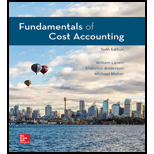
Fundamentals of Cost Accounting
6th Edition
ISBN: 9781260708783
Author: LANEN, William
Publisher: MCGRAW-HILL HIGHER EDUCATION
expand_more
expand_more
format_list_bulleted
Concept explainers
Textbook Question
Chapter 3, Problem 21CADQ
Consider the Business Application, “Cost-Volume-Profit Analysis and On-Demand Services.” In that item, Lee was quoted as saying about a leased parking space, “If we turn it over X amount of times, per-unit it becomes cheaper.” What does he mean when he says it becomes cheaper? Does the price Luxe pays go down the more it is used?
Expert Solution & Answer
Want to see the full answer?
Check out a sample textbook solution
Students have asked these similar questions
Solve this question and accounting question
General accounting
I need help with this solution and accounting question
Chapter 3 Solutions
Fundamentals of Cost Accounting
Ch. 3 - Write out the profit equation and describe each...Ch. 3 - What are the components of total costs in the...Ch. 3 - How does the total contribution margin differ from...Ch. 3 - Compare cost-volume-profit (CVP) analysis with...Ch. 3 - Fixed costs are often defined as fixed over the...Ch. 3 - Prob. 6RQCh. 3 - What is the margin of safety? Why is this...Ch. 3 - Prob. 8RQCh. 3 - Write out the equation for the target volume (in...Ch. 3 - How do income taxes affect the break-even...
Ch. 3 - Why is it common to assume a fixed sales mix...Ch. 3 - What are some important assumptions commonly made...Ch. 3 - Prob. 13CADQCh. 3 - Prob. 14CADQCh. 3 - The typical cost-volume-profit graph assumes that...Ch. 3 - The assumptions of CVP analysis are so simplistic...Ch. 3 - Prob. 17CADQCh. 3 - Consider a class in a business school where volume...Ch. 3 - Prob. 19CADQCh. 3 - Prob. 20CADQCh. 3 - Consider the Business Application,...Ch. 3 - Consider the Business Application,...Ch. 3 - Prob. 23CADQCh. 3 - Profit Equation Components Identify each of the...Ch. 3 - Profit Equation Components Identify the letter of...Ch. 3 - Basic Decision Analysis Using CVP Anus Amusement...Ch. 3 - Basic CVP Analysis The manager of Dukeys Shoe...Ch. 3 - CVP AnalysisEthical Issues Mark Ting desperately...Ch. 3 - Basic Decision Analysis Using CVP Derby Phones is...Ch. 3 - Prob. 30ECh. 3 - Basic Decision Analysis Using CVP Warner Clothing...Ch. 3 - Basic Decision Analysis Using CVP Refer to the...Ch. 3 - Prob. 33ECh. 3 - Prob. 34ECh. 3 - Analysis of Cost Structure Spring Companys cost...Ch. 3 - CVP and Margin of Safety Bristol Car Service...Ch. 3 - CVP and Margin of Safety Caseys Cases sells cell...Ch. 3 - Prob. 38ECh. 3 - Prob. 39ECh. 3 - Refer to the data for Derby Phones in Exercise...Ch. 3 - Refer to the data for Warner Clothing in Exercise...Ch. 3 - CVP with Income Taxes Hunter Sons sells a single...Ch. 3 - CVP with Income Taxes Hammerhead Charters runs...Ch. 3 - Prob. 44ECh. 3 - Prob. 45ECh. 3 - Prob. 46ECh. 3 - Prob. 47ECh. 3 - CVP Analysis and Price Changes Argentina Partners...Ch. 3 - Prob. 49PCh. 3 - CVP AnalysisMissing Data Breed Products has...Ch. 3 - Prob. 51PCh. 3 - Prob. 52PCh. 3 - CVP AnalysisSensitivity Analysis (spreadsheet...Ch. 3 - Prob. 54PCh. 3 - Prob. 55PCh. 3 - Extensions of the CVP ModelSemifixed (Step) Costs...Ch. 3 - Prob. 57PCh. 3 - Extensions of the CVP ModelTaxes Odd Wallow Drinks...Ch. 3 - Prob. 59PCh. 3 - Prob. 60PCh. 3 - Extensions of the CVP ModelTaxes Toys 4 Us sells...Ch. 3 - Extensions of the CVP AnalysisTaxes Eagle Company...Ch. 3 - Extensions of the CVP ModelMultiple Products...Ch. 3 - Extensions of the CVP ModelMultiple Products...Ch. 3 - Prob. 65PCh. 3 - Prob. 66PCh. 3 - Prob. 67PCh. 3 - Prob. 68PCh. 3 - Extensions of the CVP ModelMultiple Products and...Ch. 3 - Extensions of the CVP ModelTaxes With Graduated...Ch. 3 - Prob. 71PCh. 3 - Financial Modeling Three entrepreneurs were...
Knowledge Booster
Learn more about
Need a deep-dive on the concept behind this application? Look no further. Learn more about this topic, accounting and related others by exploring similar questions and additional content below.Similar questions
- I want the correct answer with accountingarrow_forwardI want the correct answer with accounting questionarrow_forwardOriole Company sells product 2005WSC for $55 per unit and uses the LIFO method. The cost of one unit of 2005WSC is $52, and the replacement cost is $51. The estimated cost to dispose of a unit is $6, and the normal profit is 40% of selling price. At what amount per unit should product 2005WSC be reported, applying lower-of-cost-or-market?arrow_forward
arrow_back_ios
SEE MORE QUESTIONS
arrow_forward_ios
Recommended textbooks for you
 Excel Applications for Accounting PrinciplesAccountingISBN:9781111581565Author:Gaylord N. SmithPublisher:Cengage LearningPrinciples of Accounting Volume 2AccountingISBN:9781947172609Author:OpenStaxPublisher:OpenStax College
Excel Applications for Accounting PrinciplesAccountingISBN:9781111581565Author:Gaylord N. SmithPublisher:Cengage LearningPrinciples of Accounting Volume 2AccountingISBN:9781947172609Author:OpenStaxPublisher:OpenStax College

Excel Applications for Accounting Principles
Accounting
ISBN:9781111581565
Author:Gaylord N. Smith
Publisher:Cengage Learning

Principles of Accounting Volume 2
Accounting
ISBN:9781947172609
Author:OpenStax
Publisher:OpenStax College
Cost-Volume-Profit (CVP) Analysis and Break-Even Analysis Step-by-Step, by Mike Werner; Author: Accounting Step by Step;https://www.youtube.com/watch?v=D0MOfse9OWk;License: Standard Youtube License